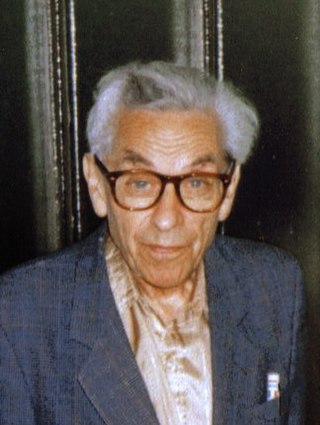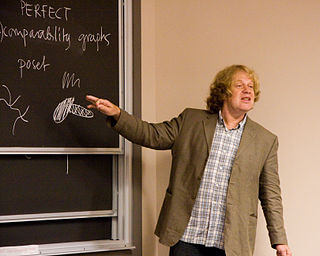In additive number theory, the Schnirelmann density of a sequence of numbers is a way to measure how "dense" the sequence is. It is named after Russian mathematician Lev Schnirelmann, who was the first to study it.
In mathematics, −1 is the additive inverse of 1, that is, the number that when added to 1 gives the additive identity element, 0. It is the negative integer greater than negative two (−2) and less than 0.
In arithmetic combinatorics, Szemerédi's theorem is a result concerning arithmetic progressions in subsets of the integers. In 1936, Erdős and Turán conjectured that every set of integers A with positive natural density contains a k-term arithmetic progression for every k. Endre Szemerédi proved the conjecture in 1975.

Paul Erdős was a Hungarian mathematician. He was one of the most prolific mathematicians and producers of mathematical conjectures of the 20th century. Erdős pursued and proposed problems in discrete mathematics, graph theory, number theory, mathematical analysis, approximation theory, set theory, and probability theory. Much of his work centered around discrete mathematics, cracking many previously unsolved problems in the field. He championed and contributed to Ramsey theory, which studies the conditions in which order necessarily appears. Overall, his work leaned towards solving previously open problems, rather than developing or exploring new areas of mathematics.
In additive number theory, the Fermat polygonal number theorem states that every positive integer is a sum of at most nn-gonal numbers. That is, every positive integer can be written as the sum of three or fewer triangular numbers, and as the sum of four or fewer square numbers, and as the sum of five or fewer pentagonal numbers, and so on. That is, the n-gonal numbers form an additive basis of order n.
In additive combinatorics, the sumset of two subsets and of an abelian group is defined to be the set of all sums of an element from with an element from . That is,
In number theory, zero-sum problems are certain kinds of combinatorial problems about the structure of a finite abelian group. Concretely, given a finite abelian group G and a positive integer n, one asks for the smallest value of k such that every sequence of elements of G of size k contains n terms that sum to 0.
Additive number theory is the subfield of number theory concerning the study of subsets of integers and their behavior under addition. More abstractly, the field of additive number theory includes the study of abelian groups and commutative semigroups with an operation of addition. Additive number theory has close ties to combinatorial number theory and the geometry of numbers. Two principal objects of study are the sumset of two subsets A and B of elements from an abelian group G,
Graduate Texts in Mathematics (GTM) is a series of graduate-level textbooks in mathematics published by Springer-Verlag. The books in this series, like the other Springer-Verlag mathematics series, are yellow books of a standard size. The GTM series is easily identified by a white band at the top of the book.
In additive number theory and combinatorics, a restricted sumset has the form
The New York Number Theory Seminar is a research seminar devoted to the theory of numbers and related parts of mathematics and physics.
In mathematics, arithmetic combinatorics is a field in the intersection of number theory, combinatorics, ergodic theory and harmonic analysis.
Hans-Egon Richert was a German mathematician who worked primarily in analytic number theory. He is the author of a definitive book on sieve theory.

János Pach is a mathematician and computer scientist working in the fields of combinatorics and discrete and computational geometry.
Jon Hal Folkman was an American mathematician, a student of John Milnor, and a researcher at the RAND Corporation.
Gregory Abelevich Freiman is a Russian mathematician known for his work in additive number theory, in particular, for proving Freiman's theorem. He is Professor Emeritus in Tel Aviv University.
In the branch of mathematics known as additive combinatorics, Kneser's theorem can refer to one of several related theorems regarding the sizes of certain sumsets in abelian groups. These are named after Martin Kneser, who published them in 1953 and 1956. They may be regarded as extensions of the Cauchy–Davenport theorem, which also concerns sumsets in groups but is restricted to groups whose order is a prime number.
In mathematics, the Davenport constantD(G ) is an invariant of a group studied in additive combinatorics, quantifying the size of nonunique factorizations. Given a finite abelian group G, D(G ) is defined as the smallest number such that every sequence of elements of that length contains a non-empty subsequence adding up to 0. In symbols, this is

Abraham Ginzburg (1926–2020) was a Professor Emeritus of Computer Science. He served as Vice President of the Technion Institute, and President of the Open University of Israel
Antisemitism in Soviet mathematics was a manifestation of hostility, prejudice and discrimination in the Soviet Union towards Jews in the scientific and educational environment related to mathematics.



